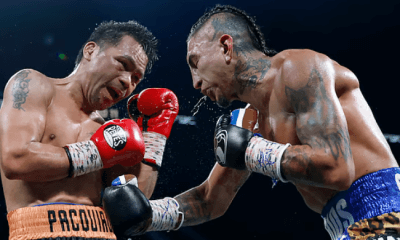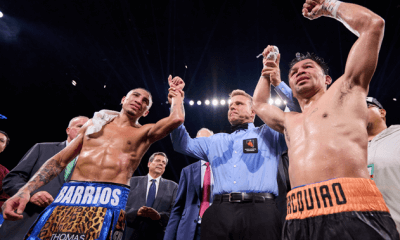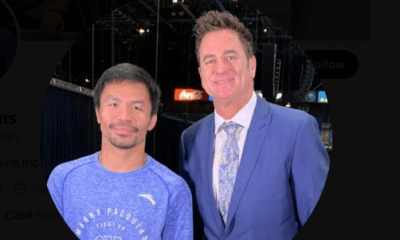Articles
“JUST WATCH MAH SMOKE” PART 8: Traveling Light
 Chicago State Hospital, dormitory ward.
Chicago State Hospital, dormitory ward.
After Cocoa Kid’s sparring session with Sugar Ray Robinson in the summer of 1949, I lost him. I was groping in the dark for a while, staring down dead ends, wondering where he went and where to go to find him. I thought of those 153 men he jabbed blind before stepping off into the periphery, into the smoke. I knew how they felt.
Chicago seemed a good place to rummage around. Perched as it is on the windy shores of Lake Michigan, Chicago would make sense to him. I knew that he had six fights there when his career winded down, and that the Daily Tribune mentioned him living there after his knockout of Ray Barnes. Then I found a marriage license filed with the Cook County Clerk in 1951. It announced the marriage of Marguerite Winrou to one Louis Herbert Hardwick.
He routinely used his middle name for his first name and seems to have habitually misspelled it. Louis is actually Lewis, and his father’s hand-written signature on a 1917 draft card proves it. His last name varied by one letter. “Hardwick” was the name he gave before boarding the S.S. Ponce in Puerto Rico in 1930. It was the one he gave at the hearing before the Connecticut State Athletic Commission in 1935. He also spelled it Harwick. A New Haven telephone directory from 1933 records a Louis E. Harwick living on Dixwell Avenue with his wife Maria. The Holyoke Daily Transcript and Telegram from the same year has Lewis claiming that he was given the name Elberto Louis Harwick at birth.
It is not unlikely that he was given a Spanish name when he was born in Puerto Rico. His mother may have doubted that the American seaman she met and slept with while he was on liberty in Mayaguez would ever return. When the seaman did return and brought them both to live in Georgia, the infant was renamed ‘Herbert Lewis Hardwick’ for him. But Lewis came to identify more with his Puerto Rican heritage. In the forties, he began referring to himself as Luis. In 1948, he told the Chicago Daily Tribune that he was born Luis Humberto. Indeed, his use of the names “Elberto” and “Humberto” may indicate a desire to spice up an Anglican name –Herbert– that he was probably not fond of. Long after both of his parents were dead, he would include his mother’s maiden name (Arroyo) when asked his name by reporters. According to the late Allen Rosenfeld, the name printed on his boxing license was Louis Hardwick Arroyo.
I believe that all of this reflects an attachment not to his mother but to his aunt.
At the hearing following the Oakland Billy Smith fight, he said that his poor performance was due to his anxiety about his “sick mother.” This could only have been his mother’s sister, Antonia Arroyo. It was Aunt Antonia who raised him and immersed him in her native culture. Her influence on his personality can be imagined.
In his younger days, he was confident and even cocky, but he also exhibited class. He would give credit where credit was due and was not averse to apologizing for knocking down a sparring partner. When an opponent named Wild Bill McDowell disrespected him over the air at a local radio station during a pre-fight interview, Lewis responded gracefully: “When a man is in the ring I give him everything I have,” he said into the microphone, “but outside the ring I treat him like a gentleman.” An article in the Washington Post tells us more. His habits were those of an introvert; he enjoyed listening to his portable radio and reading health magazines when he wasn’t boxing. He was a fitness fanatic long before it was in style and it showed in his build, particularly during his peak.
But peaks don’t last long. Neither do purses. In an era where purses were respectable but nothing close to the loot of later decades, he could have made a decent living if he saved or invested wisely, but he did not. Sometimes the purses he took weren’t even his: The day after a fight in the spring of 1939, New York City police officers fired two shots in the air and arrested Lewis for running off with a woman’s purse. It wasn’t the first time he was arrested and it wouldn’t be the last time he was desperate.
Desperation steadily drips behind the life journey of Cocoa Kid. It began on a sea of mystery when a ship disappeared and in the tears of a mother who learned that her husband was gone with it. It is in an orphan’s decision to become a fighter at fourteen. It is hinted at in references to his troubled marriage and his fear of losing custody of his children. It is there in the silence of opportunities that never came, in his stand against a well-connected manager, and in his dive a decade later. This desperation had tragic consequences as he aged; it put him in the ring against horrific punchers even after the fog of dementia set in.
In 1950 Lewis was retired from the ring and living in a basement room in the Bronx. It was burglarized, and he blamed the superintendents. His military discharge papers were taken along with his social security card. In a hand-written letter to the Navy to secure new papers, he pleaded for advice “as to what steps I should take.” What upset him most was his belief that his family photographs were stolen. Among them, he wrote, were photographs of “my sons whom I have lost.”
By 1955 he was living on 64th Street in Chicago and looking for a job. In an application for a certificate in lieu of lost military papers, he reported that he was held up and his discharge papers were stolen along with his compensation checks. “Please expedite” was typed and underlined on the application. A month later, he hadn’t received a reply and so sent in a second request; only by then he no longer had a home address.
Everything fell apart. “The Cocoa Kid, great welterweight of the 30's and 40's,” claimed the Police Gazette in early 1961, “is a wino derelict along New York's Tenth Avenue.” This claim may be corroborated by a set of facts newly uncovered. In 1958, Lewis drifted back to New York City and lost his discharge papers again. On April 17th 1959, he filled out a form at a local Veterans Administration office and recorded his address as “general delivery, c/o Main Post Office 33 + 8th Ave N.Y.C. N.Y.”
–He was homeless.
The handwriting on the form bears the marks of the mentally ill. On every previous military document, his signature read Luis Humberto Harwick. Suddenly, we see him writing his name in a painstaking manner, as if straining to sift through an addled memory. He writes “Heriberto” as his first name, and seems to be moving closer to who he was: Elberto, Humberto, Heriberto… Herbert. He writes “Lewis” as his middle name. Lewis –it is finally spelled as it was intended, as his father’s was. His damaged mind is scrolling backwards into childhood. The last name spells “Harwitz.” He records the wrong date of birth (“Jan. 9, 1916”) and scrawls “Mexico” as his place of birth.
At 44, he was wandering the streets of New York and needed help. Someone came through and lent a hand because he was admitted into Chicago State Hospital soon after filling out that application.
Then known as Dunning Asylum, the gothic buildings of the hospital were antiquated and overcrowded. Many patients, cast off by families who could not cope, lie strapped to their beds or were forced to sleep on mats lining the narrow, windowless hallways. Lewis remained there for an unspecified amount of time, though hospital personnel didn’t know who he was, and neither did he anymore. He was called “Herbert Horowitz.” In an effort to identify him, administrators sent his fingerprints to the Naval Record Management Center in St. Louis –the same office that I contacted to identity him again over fifty years later.
It was the Veterans Administration that took care of him during those years of estrangement and destitution after boxing. There was no one else. Lewis was eventually transferred to the VA Hospital in North Chicago. He died there one winter’s day in 1966.
…
February, 2011. It is an hour’s ride from North Chicago up the coast of Lake Michigan to the gates of Wood National Cemetery. The cemetery is located in Milwaukee, Wisconsin. It opened on the property of the Soldiers Home in 1871 and was originally used to inter the remains of veterans who died at the home, including several Buffalo Soldiers and members of the 54th Colored Regiment of Massachusetts.
Fifty acres of white granite headstones are arrayed in perfect symmetry to commemorate lives less perfect. They stand in reproach of time and its lengthening shadows.
I found him here, at last.
Engraved on one of those headstones is the name “Herbert Lewis Hardwick” of “Georgia.” His grave is buried under a blanket of snow. It marks a journey buried under six decades of history. The snow is thawing.

Tomorrow, Lake Michigan will sparkle in the distance as dawn’s golden hues spill across the eastern sky. A breeze will caress ground no footsteps tread, stirring the early morning mist and sending it waifing
…like smoke.
…..
The opening photograph is from asylumprojects.com. Special thanks to Andrew Jacobs, C.F., Program Support Assistant at Wood National Cemetery for the photograph of the headstone.
The whereabouts of Herbert Lewis Hardwick during the 1950s was revealed through correspondence located in the military service record of Luis Humberto Harwick/Cocoa Kid obtained from the National Personnel Records Center, Military Personnel Records, in St. Louis, MO through the Freedom of Information Act. The description of Dunning Asylum derived from an unpublished article by Richard J. Vachula, 7/11/88.
The origins of Cocoa Kid were determined with the help of the following sources: Atlanta Constitution, “Louis Hardwick is Missing,” 8/9/01; 1900 U.S. Census (Lewis Hardwick of Atlanta, GA); Lewis Hardwick’s draft card dated June 6, 1917; New York Times, “Collier Cyclops Overdue A Month” 4/15/18 and Atlanta Constitution 4/15/18 front page; U.S.S. Cyclops; Officers and Enlisted Men of the United States Navy Who Lost Their Lives during the World War –published by the Government Printing Office; Holyoke Daily Transcript and Telegram 5/23/33 and 5/24/33, 1930 U.S. Census (E.A. Robinson of Atlanta, GA). Also see Chicago Daily Tribune 2/23/48, Hartford Courant 5/3/35. His use of the name “Arroyo” (as “Aroya”) can be seen in the New York Times and the Hartford Courant 8/6/41 and the Chicago Daily Tribune 9/2/41. Arroyo was his mother’s maiden name. Knowing that E.A. (Edward Allen) Robinson was his uncle and his wife’s name was Antonia allowed me to locate the Sanabria-Terreforte family tree. That confirmed that Antonia was born in Mayaguez and her maiden name was Arroyo. This solved the mystery of Cocoa Kid’s use of that name.
Lewis alternated between “Hardwick” and “Harwick.” Why he did is unclear. The official record of interment obtained from the US Department of Veterans Affairs states that “name of deceased” is “Luis Harwick” though the “name of the deceased exactly as it is to appear on headstone or marker” is given as “Herbert Lewis Harwick.” The surname of the next of kin on the document reads “Hardwick.”
The Washington Post reported Lewis’s apology to El Brookman after knocking him down during sparring (7/13/40), his on-air exchange with Wild Bill McDowell (6/18/40), and his introverted habits (6/17/40). Johnny Bos was kind enough to supply the report of Lewis’s arrest (The Chicago Defender 3/25/39).
Boxing historian Alister Scott Ottesen was very helpful in determining The Ring rankings for several fighters discussed in this series. The due diligence of Laura Magere, Communications Specialist for the Freedom of Information Act in Washington D.C. enabled me to exercise my own due diligence. I am grateful to Dan Cuoco, director of the International Boxing Research Organization who remains a prince for the long-forgotten fighters of history. Special thanks to boxing historian Ed Cahill for his willingness to help this stranger on his own secret journey.
I encourage readers to visit the grave of this great and tragic fighter, located in Wisconsin at Wood National Cemetery, section 36a, row 11, site 3.
Cocoa Kid still needs a hand. In October, the voting members of the BWAA should be contacted on his behalf and urged to vote him into the International Boxing Hall of Fame.
Springs Toledo can be contacted at scalinatella@hotmail.com.
-

 Featured Articles2 weeks ago
Featured Articles2 weeks agoResults and Recaps from New York Where Taylor Edged Serrano Once Again
-

 Featured Articles2 weeks ago
Featured Articles2 weeks agoResults and Recaps from NYC where Hamzah Sheeraz was Spectacular
-

 Featured Articles2 weeks ago
Featured Articles2 weeks agoFrom a Sympathetic Figure to a Pariah: The Travails of Julio Cesar Chavez Jr
-

 Featured Articles2 weeks ago
Featured Articles2 weeks agoPhiladelphia Welterweight Gil Turner, a Phenom, Now Rests in an Unmarked Grave
-

 Featured Articles3 weeks ago
Featured Articles3 weeks agoCatterall vs Eubank Ends Prematurely; Catterall Wins a Technical Decision
-

 Featured Articles5 days ago
Featured Articles5 days agoManny Pacquiao and Mario Barrios Fight to a Draw; Fundora stops Tim Tszyu
-

 Featured Articles3 days ago
Featured Articles3 days agoArne’s Almanac: Pacquiao-Barrios Redux
-

 Featured Articles1 week ago
Featured Articles1 week agoFrom the Boondocks to the Big Time, The Wild Saga of Manny Pacquiao’s Sidekick Sean Gibbons










